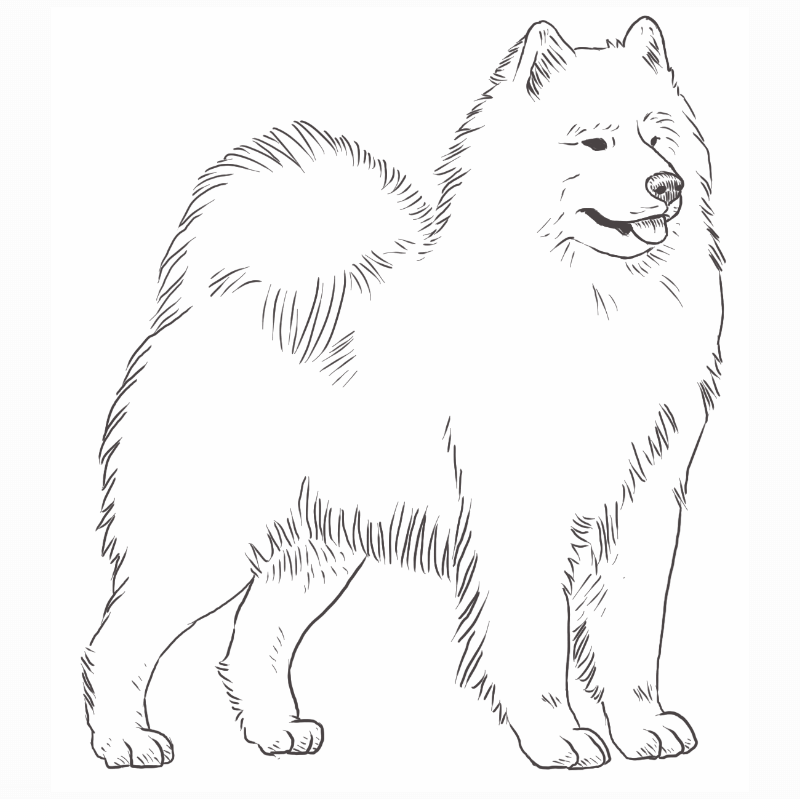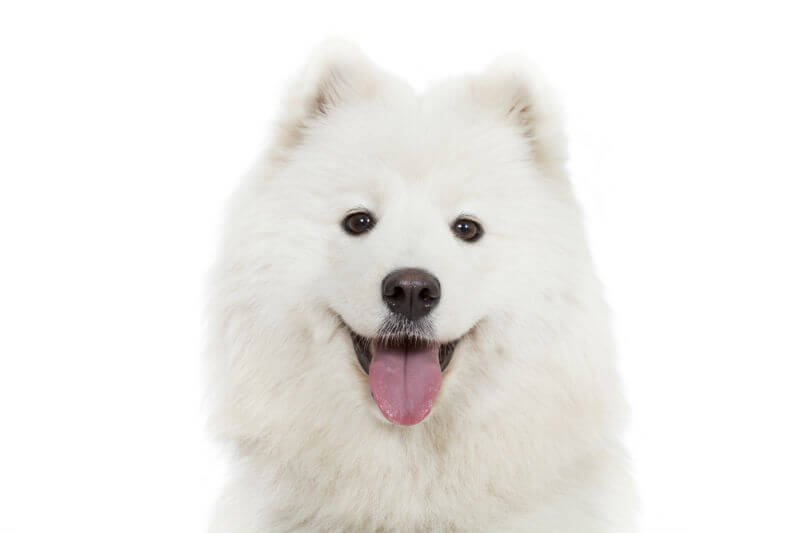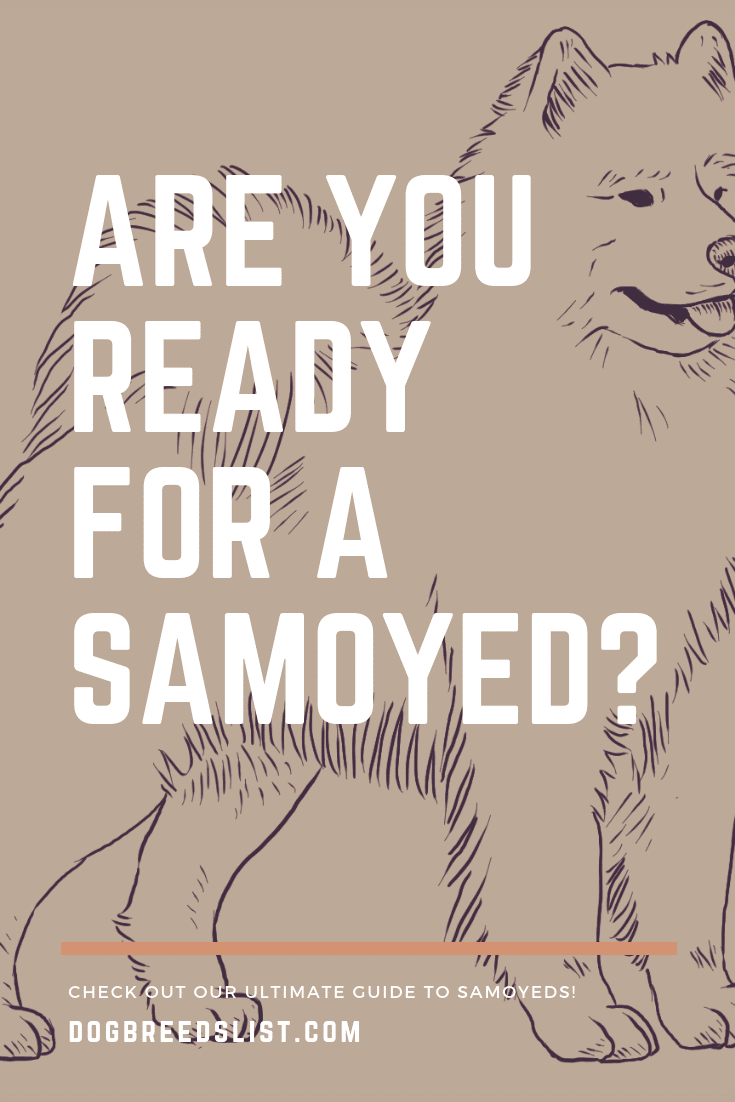Samoyed
Samoyed Facts
- Breed Type: Purebred
- Size: Medium
- Lifespan: 12 – 13 years
- Temperament: Alert, Friendly, Lively, Playful, Sociable, Stubborn
- Colors: Cream, White, White and Biscuit
- Hypoallergenic: Yes
- Related Dog Breeds:
- Alaskan Malamute
- Samoyed
- Siberian Husky

Samoyeds are gentle giants with friendly smiles and fluffy white coats. They’re kind, loyal, and one of the most dependable dog breeds by nature yet their bodies are sturdy and able to do some heavy work.
Spoiler Alert: Despite their cuteness and positive characteristics, Samoyeds aren’t for everyone.
Samoyeds aren’t just pets.
They are another member of the family and will need to be treated like one. This means lots of attention, care, and time together.
So, if you have plenty of patience, prefer an active skiing holiday over lazing by the beach in the Caribbean, are OK with never being alone, and don’t mind regularly picking off white hairs from your clothes and furniture…
….keep reading.
History
The fluffy white coat should serve as a clue.
Samoyeds originate from Siberia, one of the coldest places in the world. There, the nomad tribes of the Samoyedic peoples used them to pull sleds, keep themselves warm, as well as hunt and herd reindeer.
The Samoyedic treated their dogs as family members and lived together with them in tents.
Because of that, Samoyeds developed into a kind, friendly, and loyal breed.
Are Samoyeds Good Family Dogs?
Samoyeds are friendly, loyal, gentle, and playful. So, they aren’t just good family dogs, they are another family member and wish to be treated like one.
Samoyeds love taking part in family activities and are very fond of children.
If you choose to own a Samoyed, be ready to treat it like a child of yours. It will likely require just as much attention and affection.
But don’t worry:
You’ll get the same love and affection in return!
Care
If you’ve looked into getting a Samoyed puppy, you’ve likely been told quite a few convincing facts about how easy it is to keep a Samoyed clean.
Don’t let yourself get fooled though.
Samoyeds are easy to keep clean if you are ready to roll up your sleeves and make the effort. They also require quite a bit of attention to their exercise and diet.
Nutrition
A Samoyed puppy grows very fast.
That’s why you should always feed it high-quality food that will sustain such rapid growth. You can out for high-quality dog foods as well as lean meats such as beef and chicken.
Samoyeds can be picky eaters.
Make sure to set good eating habits now as it will help to keep them as your dog matures without wrecking your nerves or your budget.
An adult Samoyed will thrive on lean high-quality food. Make sure to not let your dog get fat. Reduce rations and cut down fats if need be. Always talk to your vet first if you have any concerns.
Treats can be great for training, but don’t get too excited about them either. Samoyeds can easily become obese.
“Just say no” to sharing table scraps, as well.
Have water available at all times. During the hot summer months, serve an ice cube with your adult Samoyed’s drink, as well.
And by drink, I mean water. ;-)
Grooming
Samoyeds have a thick double coat that needs regular grooming. Expect them to shed a fair amount all year long.
Brush at least two or three times a week to remove soil, dirt, and loose hairs. During shedding periods, it’s best to do it every day.
You can even use a wet towel on particularly dirty days.
Washing your dog’s feet regularly will also help keep its appearance (and your furniture) presentable. Use a metal comb or a slicker brush for mats and tangles.
Clip your Samoyed’s nails every three to four weeks and regularly brush its teeth with dog toothpaste a few times a week. It will help to prevent tartar buildup and gum disease.
Bathe him or her at least twice a year.
Exercise
Samoyeds need exercise.
Dedicate at least 40-60 minutes a day to it. Long walks on a leash and playing in fenced-in yards are great for Samoyeds.
They also like taking part in family play and activities.
Training
Samoyeds are social animals and love being around humans.
They are generally well-behaved, yet when it comes to training, it may be a challenge….because they won’t always listen. They are also quite independent, and can even be stubborn and resist training.
To keep their interest sharp, provide plenty on positive reinforcement for good behavior and keep training sessions short.
Train your Samoyed gently and lovingly but firmly. Avoid being harsh as your dog may stop listening to you at all.
Samoyed Health Issues
Samoyeds are an ancient breed and have not gone through much genetic manipulation.
Moreover, because of the harsh and cold climate only the sturdiest and healthiest specimens survived.
As a result, Samoyeds are a rather healthy breed. With proper care and diet, they can stay happy and healthy and live up to 12-13 years.
The most common health conditions that your Samoyed may experience are:
- Hip dysplasia
- Progressive retinal atrophy
- Cataracts
- Glaucoma
- Dental diseases
- Heart issues
- Diabetes
- Obesity
- Hypothyroidism
Everything Else You Need to Know About Owning a Samoyed
1. They Went on Expeditions
During the end of the 19th century, explorers took Samoyeds on expeditions to the North and South poles. That was due to their stamina, trainability, and resistance to cold.
Have you learned about the Norwegian explorer Roald Amundsen in school?
He was the first person to ever reach the South Pole as well as the first one to lead expeditions to both the South and North Poles.
He used Samoyeds to pull sleds on his expeditions in Antarctica.
As a matter of fact, some even believe that a Samoyed was the first non-native creature to ever set foot on the South Pole.
Well, paw, but that’s a cool fact nonetheless!
2. Samoyeds are Rather New to Europe and the USA
The Arctic and Antarctic expeditions were the first time Samoyeds ventured out of Siberia.
And it was only during the late 19th century when Samoyeds from these expeditions were introduced to the high classes of the UK.
Then, they got royal attention.
Alexandra of Denmark became the Queen of England after marrying Kind Edward VII. She received a Samoyed as a gift and was instantly in love. Soon after, she became a dedicated Samoyed breeder.
That’s excellent PR for a breed, isn’t it?
It’s believed that many of today’s Samoyeds may have descended from the dogs in the Queen’s kennels.
The first Samoyed in the US was registered in 1906.
3. Your Samoyed Likely Descends from Veteran Expedition Dogs
The expeditions to the Poles were harsh and only the fittest and strongest of the Samoyeds survived.
Many died from pneumonia.
So, the majority of the Samoyeds that currently live in the West, are most likely descendants of the dogs that pulled sleds during these expeditions.
4. You are Likely Mispronouncing it
Most people say Suh-MOY-ed.
Sometimes, you’ll also hear SAMmy-ed.
However, SAMma-ed is closer to what it would sound like in the native dialect.
Hey, ancient Russian dialects must have been tough, so don’t worry.
Many people also refer to Samoyeds using nicknames such as “Sams”, “Sammies”, or “Smileys” (I’ll explain that one in #6, so keep reading).
5. Samoyeds are Very Closely Related to Wolves
Samoyeds are an ancient type of dogs. In fact, they are one of the 14 breeds that are the closest to wolves.
They belong to the Spitz type dogs.
Spitz refers to Nordic breeds such as the Siberian Husky, the Akita, and the Alaskan Malamute that have thick coats, pointy ears, and a tail that’s bent at the back. These breeds are primitive and resemble wolves in their behavior and appearance.
6. The Samoyed Says “Cheese” Better than You
Samoyeds are so friendly that they actually smile.

Well, yes and no.
Their lips are black and their corners turn upwards. So, it looks like a smile. While Samoyeds are indeed very cheerful and friendly, the smile actually serves a very good purpose.
It protects Samoyeds from drooling.
What’s the big deal about drooling?
None if you are a house dog who lives in a warm climate.
But, things are a tad bit more complicated if you live in Siberia. Drooling in freezing temperatures is definitely not something you’d like to do. Unless you’d like to deal with the icicles forming by your mouth.
7. Samoyeds are No Couch Potatoes
A Samoyed isn’t the dog who can spend lots of time alone in the house. Boredom and Samoyeds just don’t go together.
A bored Samoyed can become destructive and end up chewing everything in its way and turning your house upside down. It is also very likely to bark a lot and make your neighbors very willing to call the cops.
So, make sure to provide plenty of exercise, activity, and stimulation. Especially if you spend long hours at work.
8. Samoyeds are Family Animals
This breed likes to be around people and is excellent for families with children. Yet, they usually form a strong primary attachment with one human.
So, treat your Samoyed just like another family member. To make it feel even more included, let it sleep in your bedroom.
Samoyeds are also friendly towards other dogs and even cats if raised alongside them.
On the other hand, lonely Samoyeds can become depressed, so it’s a good idea to involve them in a variety of activities. Leaving your dog tied up alone in the yard isn’t something I’d recommend for this breed either.
Regardless of how friendly Samoyeds are, it’s never a good idea to leave them (or any other dog) alone with small children.
9. Samoyeds Shed…A LOT
Given their lush double coat, this should not come as a surprise.
Samoyeds blow their coat twice a year – in the spring and before the winter. It usually takes about 5 weeks to brush the old coat out.
But that’s not it…
Samoyeds will keep shedding all year long.
The good news is that they actually enjoy being groomed. Especially if you show them plenty of love. So, that can be a great bonding time between you and your dog.
9. You Can Make Clothes from Their Fur
If you’re the crafty type, all that fur that you brush out does not have to go to waste.
Samoyed fur can be spun into yarn and used as an alternative to wool. So, you can make scarves, mittens, and even sweaters from your dog’s fur.
Crafters say that Samoyed yarn is soft, warm, and strong. Some even claim it to be their favorite type of dog fur to make clothes from!
10. Samoyeds Smell Nice
Most dogs have the peculiar “doggy odor”. Samoyeds do not as their fur is odorless. Even if they roll around in something unpleasant, the smell does not stay for long. Because of this, you need to bathe a Samoyed much less frequently than some other breeds.
That’s another reason for you to keep their fur and make clothes from it. And to snuggle with your Samoyed more frequently.
11. Keep Your Samoyed Cool
Designed for the cold, Samoyeds do not tolerate heat very well.
So, if you happen to live in a warmer geographic location, make sure to not overheat your dog.
Avoid direct sunlight and provide enough shade. When it comes to activities and playtime, it’s best to plan those early in the morning or during the evening hours when the weather is cooler.
When indoors, turn your AC on to keep the temperature cool.
And, of course, ensure that plenty of water is available at all times. It should go without saying that hot weather may also require you to schedule in more doggy business breaks. Yes, by that I mean more frequent peeing.
12. No Trimming or Shaving
Although it may seem like a good solution for the hot summer months, you should by no means shave or trim your Samoyed’s fur.
While it is dense, it insulates against both the cold and the heat. It also protects the soft pink Samoyed skin from the sun.
Instead, brush it regularly to remove any excess loose hairs.
13. Samoyeds Groom Themselves Like Cats
A Samoyed owner isn’t the only one who prides themselves in their dog’s thick and soft coat.
The dog itself does as well.
So, you may notice it displaying rather cat-like behavior when it comes to grooming their own fur. But it does help them keep it clean longer.
14. Keep Them on a Leash
When you take your Samoyed out for a walk, do not let it off the leash in large open areas. Especially if it’s young and hasn’t been trained much.
It is an independent type of a dog that may have a strong urge to run off and roam for miles. You don’t want it to get hurt or get lost. Samoyeds also like chasing small animals and even “herding” small children.
This will, however, depend on each individual dog and their training. Training your dog to obey and come back when called can minimize the risk of it.
15. Not all Samoyeds are White
While most Samoyeds will have a pure white coat, it does not apply to all dogs of this breed.
Some will be cream, biscuit, or white with silver tips.
16. They Are Vocal
Be prepared for a Samoyed to bark quite a lot.
They are a rather vocal breed and can bark when they are happy, excited, playing, or about to be fed. If left alone for a long time, they can resort to barking, as well.
With proper training, barking can be controlled…in most cases.
Samoyeds are stubborn and independent, but they are also intelligent and keen to learn. Nonetheless, be prepared for some occasional barking either way.
17. Samoyeds can be Good Watch Dogs…but not so Good Guard Dogs
Most Samoyeds are also likely to bark when someone knocks on the door or rings the bell.
However, they tend to be friendly with strangers.
So, once they are done announcing the visitor, they will most likely become kind and friendly towards them.
18. They Sing
Though you will most likely hear Samoyeds barking, they howl as well.
Yet, their howl is rather melodic and can even have a tune to it.
So, if you are looking for a breed that will jam along to your favorite songs, a Samoyed may be a fit for you.
19. Keep an Eye on Them Till the Age of Two
Relax, they won’t go through the terrible twos. Yet, two is a crucial age in the development of a Samoyed.
Samoyed puppies grow very fast and it’s important to provide them with plenty of exercise to ensure optimal development.
Yet, they can easily overexert themselves.
This can place to much strain on their muscles and joints thus compromising optimal development of other body parts and causing unnecessary wear and tear.
To prevent this from happening, make sure that your pup’s diet in high-quality.
Also, avoid letting them jump on hard surfaces, stand on their hind legs a lot, as well as leap on and off different objects.
20. Samoyed Puppies
If there’s anything else you need to to know about Samoyeds, then it’s how cute their puppies are.
They resemble mini versions of polar bears and are very playful and affectionate.
Need I say more??
In Conclusion
Samoyeds won’t be a good fit for everyone.
However, if you’ve read this far, it may be the right breed for you.
Are you a Samoyed person?
